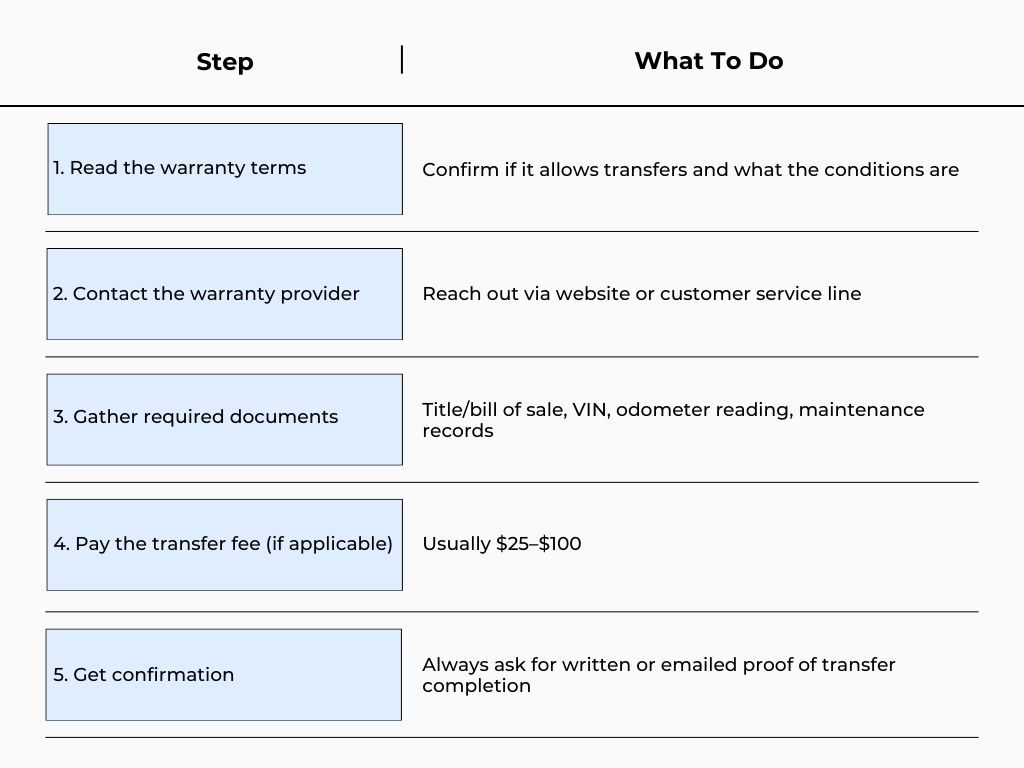Thinking of selling your car but not sure what happens to the warranty? Or maybe you’re buying a used car and the first thing on your mind is, “How to check my warranty on my car?” Either way, understanding car warranty transfers and knowing how to perform a car warranty check by VIN is crucial. A transferable warranty can increase your vehicle’s resale value and give buyers peace of mind—if you know how it works.

Here’s everything you need to know about transferring a car warranty and how buyers can confirm what’s still covered.
What Is a Transferable Car Warranty?
A transferable car warranty is a warranty—either from the manufacturer or a third-party provider—that can move from the original owner to the next when the vehicle is sold. Not all warranties are transferable, but many are, especially factory warranties and some extended coverage plans.
Types of Car Warranties
| Type | Who Provides It | Transferable? | Covers |
| Factory Warranty | Car Manufacturer | Usually Yes | Powertrain, bumper-to-bumper, emissions |
| Extended Warranty | Dealer or Third-Party | Sometimes | Repairs beyond factory warranty |
🔗 Related: How to Check Car Warranty by VIN: A Step-by-Step Guide
How to Transfer a Car Warranty
Transferring a warranty isn’t difficult, but you need to follow the correct steps and paperwork. Here’s a general guide:
✅ Steps to Transfer

💡 Tip: Always read the fine print before initiating a transfer. Some warranties can only be transferred once.
How Buyers Can Verify Car Warranty Coverage
If you’re buying a used vehicle, especially from a private seller, you’ll want to know if the car still has active warranty coverage—and whether it can be transferred to you. Here’s how to verify:
1️⃣ Ask for the Warranty Documentation
Get a copy of the original warranty documents, extended service contract, or proof of purchase. The paperwork will show the warranty terms, expiration mileage or dates, and whether it’s transferable.
2️⃣ Contact the Manufacturer or Provider
Call the automaker’s customer service line or visit their website. You’ll need the car’s VIN and current mileage to get accurate info.
3️⃣ Use a VIN Lookup Tool
A quick car warranty check by VIN can reveal whether the vehicle still has active manufacturer coverage. Some free tools can tell you the in-service date and whether the factory warranty has expired.
4️⃣ Request a Vehicle History Report
A report from services like CARFAX or AutoCheck may include warranty status, especially if the car was serviced regularly at a dealership. For broader insights, use a free VIN lookup that includes accident history, mileage records, and recall data.
Extended Warranties: What To Know
Extended warranties (or vehicle service contracts) can be trickier than factory warranties. Here’s what to look out for:
- Provider Rules Differ
Some providers make it easy to transfer coverage. Others don’t allow transfers at all or only permit it once. Always review the fine print before assuming coverage is portable. - Service History Matters
Many extended warranties require proof that the car was properly maintained. If you’re the seller, have those maintenance records ready. If you’re the buyer, ask for them. - Third-Party Warranties
Coverage from independent providers varies widely in quality. Before agreeing to transfer or accept one, read reviews and check if the company is accredited by the Better Business Bureau (BBB).
How to Check My Warranty on My Car
If you’re the current owner and unsure of your coverage, don’t worry—many drivers ask: “How to check my warranty on my car?”
Quick Ways To Check
✅Check the owner’s manual or original purchase documents
✅ Visit the manufacturer’s website and enter your VIN.
✅ Call the customer service department of the automaker or warranty provider.
✅ Use a VIN lookup tool for basic warranty data.
Knowing what coverage is still active will help you answer buyer questions confidently—and potentially justify a higher selling price.
Why Warranty Transfers Matter When Selling a Car
Offering a transferable warranty can make your vehicle stand out in a competitive used car market. Buyers are more likely to choose a vehicle that still has manufacturer or extended warranty coverage because it reduces their risk and future repair costs.
Sellers benefit too: a well-documented transferable warranty adds real value, especially if the vehicle is still relatively new or has low mileage. It’s a win-win—if you handle the transfer properly and communicate clearly.
For more tips on maximizing your resale value, check out our guide on what to check before selling your car.
Final Thoughts
Transferring a car warranty doesn’t have to be complicated. Whether you’re the seller or buyer, verifying warranty details using the VIN is a smart move. It helps avoid future disputes, ensures coverage continuity, and adds real value to your deal.
Before you sell or buy a car, do a quick warranty check—it could save time, money, and headaches.